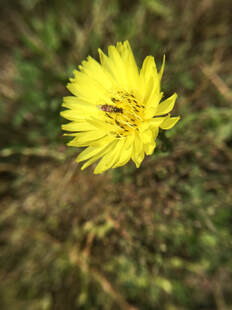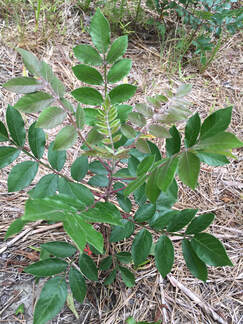
My usual 1.5 to 2 hour walks this past week took over three hours as I investigated some of the nondescript, run-of-the-mill, ordinary greenery I generally ignore. I was pleasantly surprised to discover and learn interesting facts about the ‘new to me’ plants I’d never noticed before.
Here are a few of the overlooked and underappreciated plants I discovered.
At first glance, the yellow color screams “dandelions” peeping out from the tall grass, right? Looking closer, you may notice these wildflowers are taller than the ordinary round, yellow puffballs growing everywhere. But you may still think they’re nothing special.

These Carolina Desert Chicory (Pyrrhopappus carolinianus) are few and far between along my route. However, they make up for their sparsity by keeping busy hosting a variety of pollinators, like this hoverfly. I’ve seen beetles, bees, and other bugs I couldn’t identify feeding on these native flowers. Even though they’re scarce around here, I’ve read that these volunteer plants can become invasive. If given the option, though, I’d rather have the Carolina desert-chicory in my yard than the non-native dandelions.

The American Beautyberry (Callicarpa Americana) is a ‘new to me’ native bush often mentioned as an excellent addition to any pollinator-centric landscaping in the southeastern U.S. The beautyberry doesn’t look like much at this time of year, but in the autumn, the attractive clusters of purple berries are an excellent food source for wildlife and birds. Humans can eat the bitter berries too, but folks usually prefer to make jams and jellies. One more thing, extract from the crushed leaves works as an insect repellent. I’m going to have to try that!

It caught my eye while I was wading through some tall underbrush. To be perfectly honest, Fate actually brought this plant to my attention. A conveniently placed, exposed root introduced us when my clumsy attempt at stopping my fall brought me nose to tassel with it.
That was a fortunate turn of events. Otherwise, I would never have found out that this plain-looking stalk is a protein-packed wildflower that deer, rabbits, and other mammals love to nibble on. And that’s not all. Birds eat the seeds, and bees visit the tiny flowers.
My apologies for overlooking and not appreciating the bushclover before our accidental encounter.

I initially stepped over and continued on my way, but something told me to take another look. I’m glad I backtracked because this plant is pretty cool. Sumac bushes produce clusters of berries that ripen in autumn. The berries outlive the foliage and gradually turn maroon-brown as they persist through much of the winter, providing a terrific food source for wildlife and birds. The problem is that only the female plants produce the fruit, and that’s only if there are male plants nearby and the bugs do their pollinating thing.
For domestic use, Sumacs are hardy plants that control erosion and work okay as hedges and shelter for wildlife. One drawback is they tend to spread aggressively by root suckers. To win back our favor, the leaves turn a colorful flaming red and burgundy in the fall.
 Bull thistle and green sweat bee
Bull thistle and green sweat bee Why a change of heart? The bees and butterflies convinced me that thistles were okay, up to a point. When the plants bloomed, masses of insects entertained me with their pollen-gathering dances.
Since then, I’ve developed a hands-off appreciation for Bull or Bristle Thistles (Cirsium horridulum) and Field Thistles (Cirsium discolor). Both of these are native to this area and serve a beneficial purpose. Field thistles have large flowers that produce lots of nectar and pollen, and the young leaves can be boiled up as edible greens. Not that I plan on getting that hungry.
 Creeping Thistle
Creeping Thistle The Creeping Thistle (Cirsium arvense) is a different story. It causes significant problems in agriculture since it spreads aggressively underground and smothers any and all plant life in its path. Even though the flowers attract pollinators, this species tends to do more harm than good and is considered invasive. So, this variety is a definite no-no.
Other weird and wonderful plants are out there, and I’ll continue writing about my fascinating discoveries in the coming weeks. I’ve always had a great respect for Mother Nature. However, now, I harbor a deeper appreciation for her mastery in creating such a wondrous, diverse plethora of life.
 RSS Feed
RSS Feed
